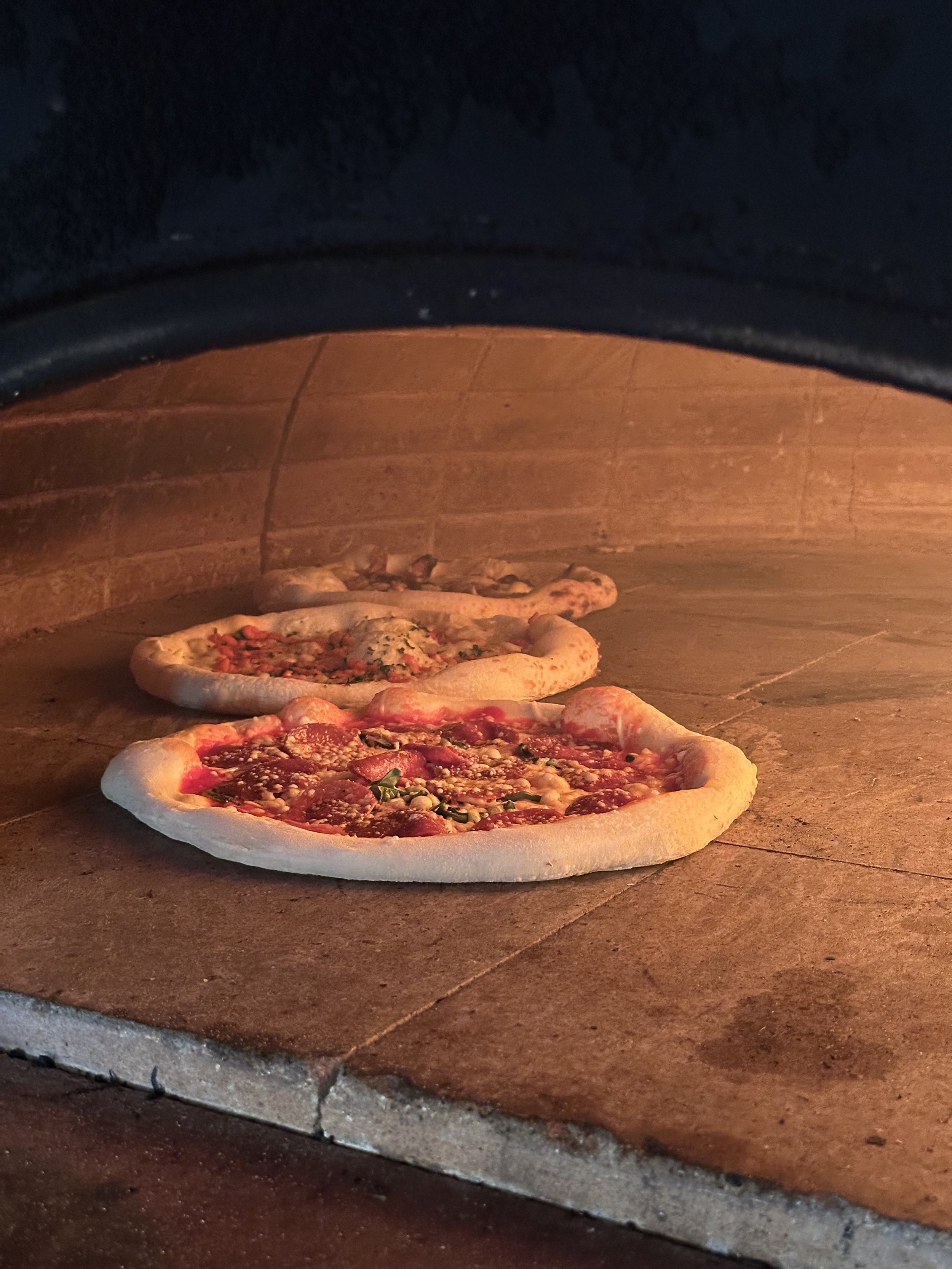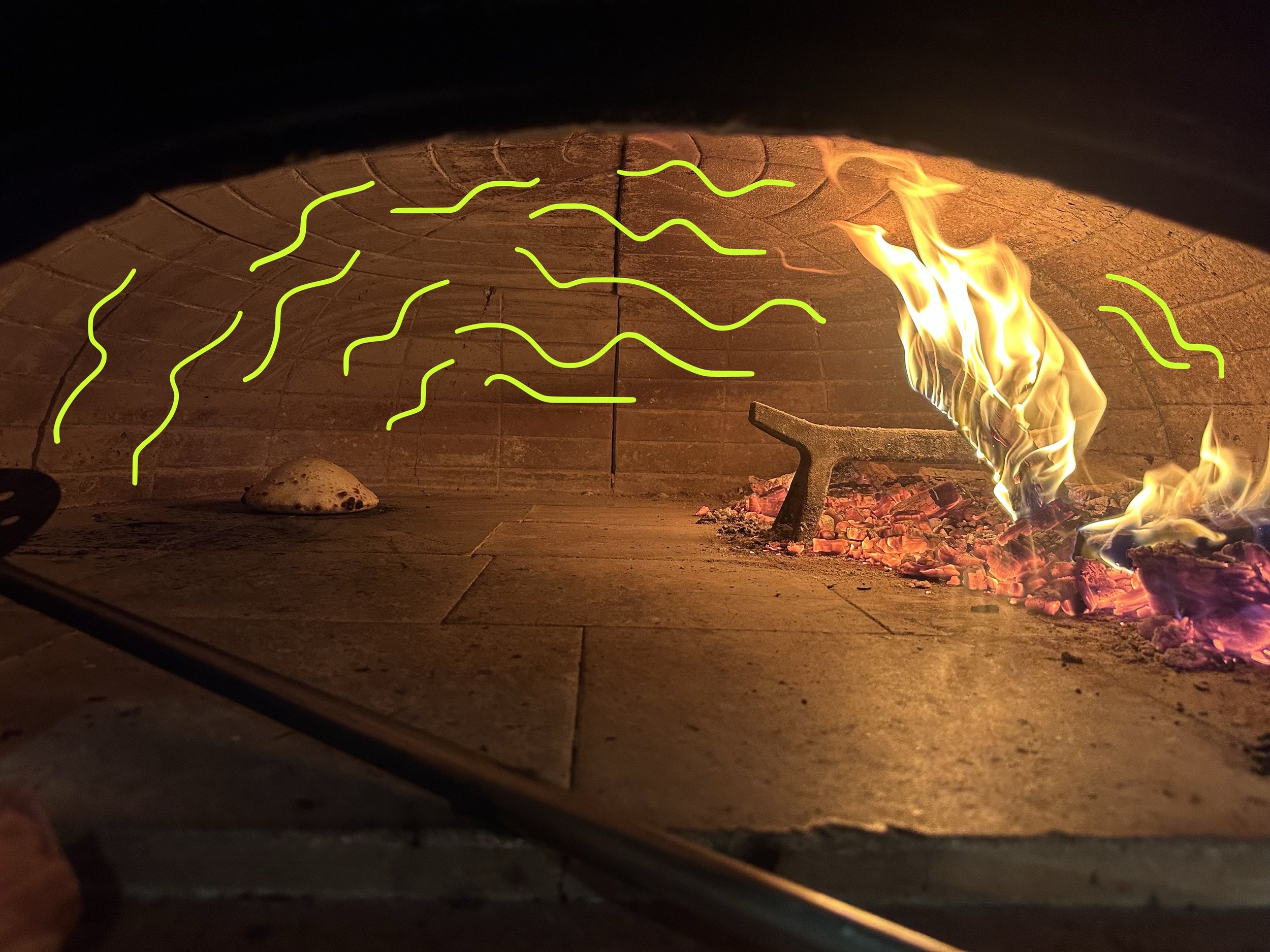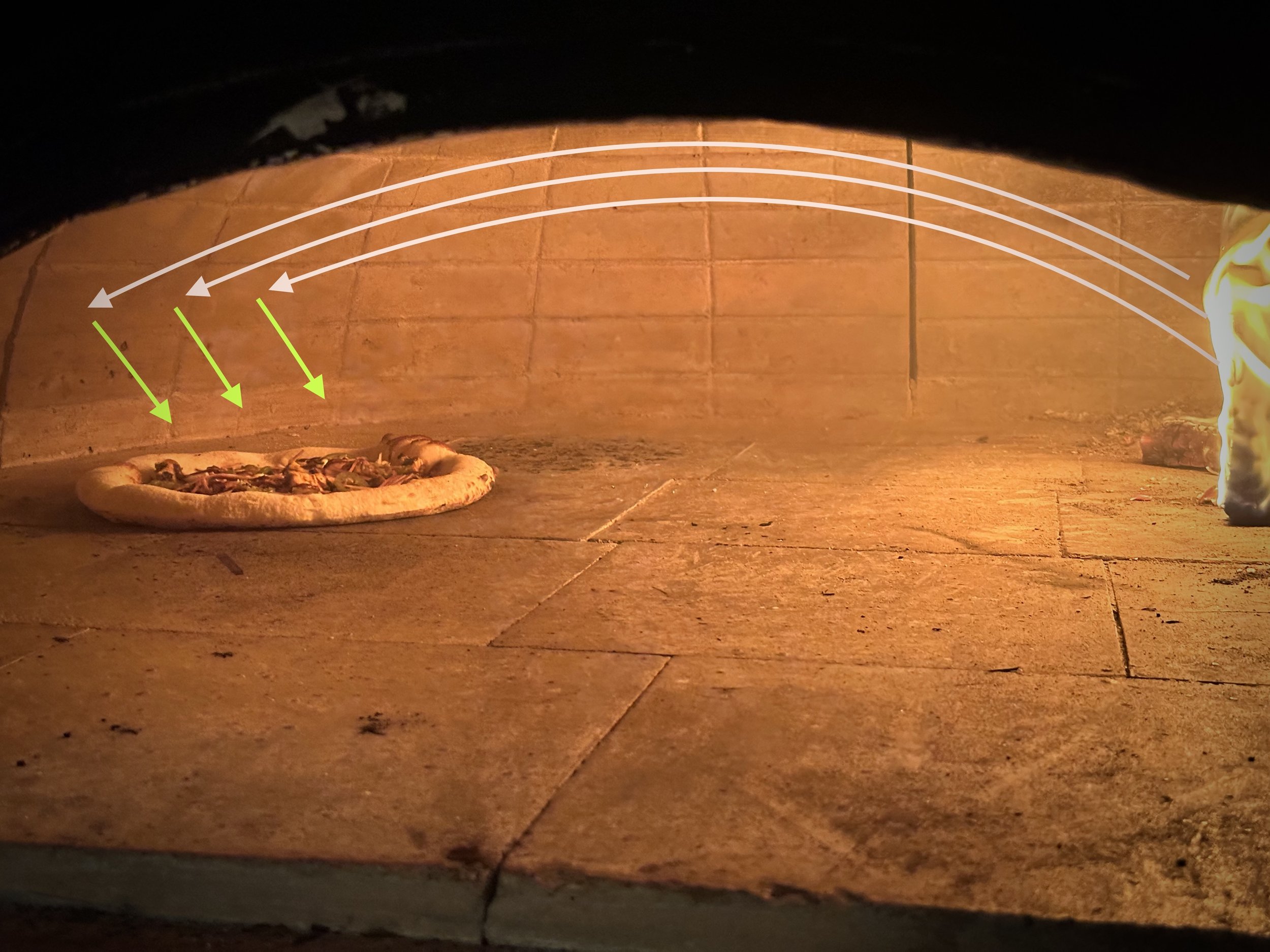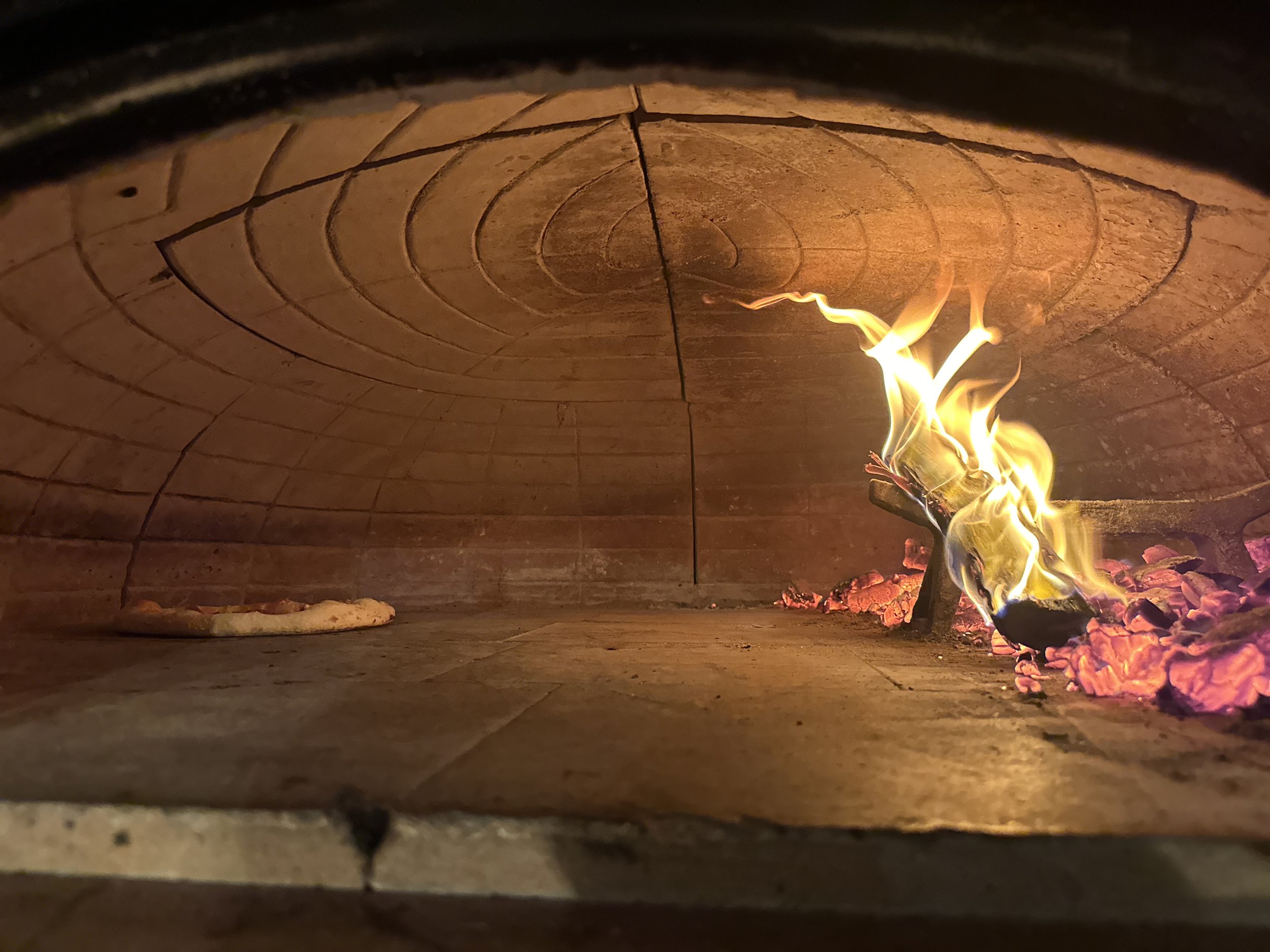5 Ways Heat Works in a Wood-Fired Oven
1 Infrared radiation
Infrared radiation is a type of energy just below visible light.
It's the main kind of heat we feel from things like flames, hot oven walls, or even the sun.
In a wood-fired oven, infrared radiation cooks the top of the pizza, caramelizing the toppings and creating that beautifully blistered crust. The closer the pizza is to the flame, the more radiant heat it absorbs.
This radiant energy spreads throughout the oven, contributing to the other forms of heat we'll explore next.
Watch the video to see it in action — notice how the right side of the crust begins to develop leopard spots and the pepperoni crisps up beautifully.
2 Conduction
This is the heat transferred through direct contact. In a wood-fired oven, the pizza sits directly on the hot oven floor (often made of stone or brick or biscotto), allowing the base to cook quickly and evenly.
In my opinion, this form of heat is one of the most crucial.
First, because up to 70% of the pizza’s cooking comes from the oven floor. If the base is too cold, the pizza won’t cook properly—no matter how well the other forms of heat are working.
Second, since wood-fired ovens don’t have built-in thermometers, you need to monitor the floor temperature yourself. This can be done with an infrared thermometer or simply by using a test pizza to see how quickly it bakes.
The key to mastering a wood-fired oven is finding the right balance between all five forms of heat. When they work in harmony, the pizza cooks evenly—from the base to the crust to the top—without needing to constantly rotate or lift it.
3 Convection
As the fire burns, fresh oxygen enters the oven while hot air and gases circulate.
This movement creates a convection current that evenly distributes heat throughout the chamber, contributing to a balanced bake.
As you can see in the image the yellow lines fakes the hot air and the gases circulating the whole oven.
Visual & Physical Indicators of Convection
So, the question you may have is how do I know the convection is happening?! Well there are a few signs you can have a look at, like:
Flame Movement: Flames dance and get pulled toward the oven dome and front opening—this means oxygen is feeding the fire and hot gases are circulating.
Rolling Heat Waves: You may see shimmering waves or distortion in the air inside the oven, especially near the dome—this is hot air moving, a sign of convection.
Even Cooking: If your pizza bakes evenly on the top (without constantly rotating it), that means hot air is circulating and cooking the surface via convection.
Ash Movement: Small ashes or soot sometimes swirl gently in the dome when convection is strong, showing air flow inside the chamber.
Draft Pull: If you hold a lit match or light piece of paper near the mouth of the oven and it pulls inward slightly, that shows air is being drawn into the chamber, feeding convection.
4 Refraction
The thick walls of a wood-fired oven absorb and store heat.
Over time, this heat is refracted—bounced back—from all angles, creating a surround-heat effect that evenly cooks the pizza.
As shown in the image, the arrows represents the refracted heat reaching the pizza. Unlike directional heat, the warmth inside the oven spreads throughout the chamber and reflects off every surface it touches.
That’s why oven design plays such a crucial role.
Models like Stefano Ferrara or Forno Santo are crafted specifically to optimize pizza cooking.
With a well-designed oven, you’ll use less wood and achieve better heat retention, resulting in more balanced and precise cooking.
Here are some signs to look for:
0. White Dome
First, always make sure the oven dome is completely white, with no black spots. This indicates that the bricks have absorbed enough heat. If parts of the dome are still black, it means the heat is still being absorbed rather than reflected — and refraction won’t occur effectively.
1. Even browning across the pizza
If your pizza cooks uniformly on top without constant rotation, it’s a good sign that heat is reflecting from the walls and dome, not just coming from the flame.
2. Steady cooking across multiple pizzas
If your oven maintains consistent performance from one pizza to the next, with minimal wood added, that shows strong heat retention and reflection from the oven structure.
3. No burnt or raw spots
When the pizza bakes evenly — without charred edges or undercooked centers — it’s a sign of well-distributed, refracted heat throughout the chamber.
4. Stable floor temperature
If your oven floor stays at a steady temperature without sudden cool patches, it's being supported by the heat circulating and bouncing within the oven.
In a nutshell, if you keep touching your pizza, rotation many times and lifting up to cook on top, that means “refraction heat” needs attention, something need to be done.
5 Your passion
This is the most important form of heat you’ll rely on in the oven.
And believe me — mastering a wood-fired oven is no easy task. There are no buttons, no built-in thermostats… it’s all about intuition and daily experience. The more you bake, the more you realise: you actually know very little.
When I first started, I often felt frustrated trying to understand what was happening inside the oven. But the more confused I got, the more determined I became to learn — to understand the chemistry and physics at play.
So if you’re just beginning and things still feel unclear, stay calm. Keep studying, keep cooking. Time will teach you.
And if you’re already experienced, never forget — there’s always something new to learn.
I hope you’ve enjoyed this post. If you have any experiences or stories you'd like to share, I’d love to hear them.
Cooking with a wood-fired oven is a lifetime journey.





